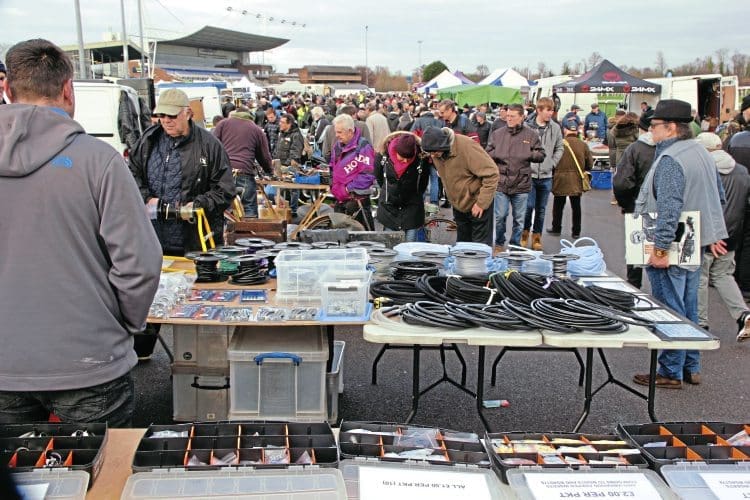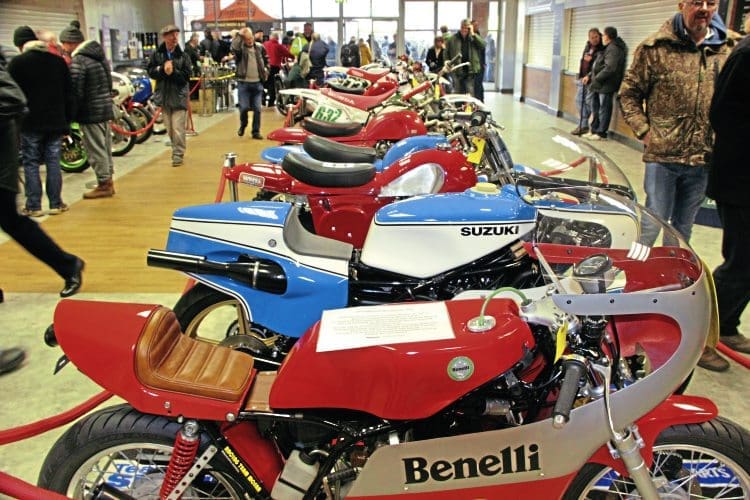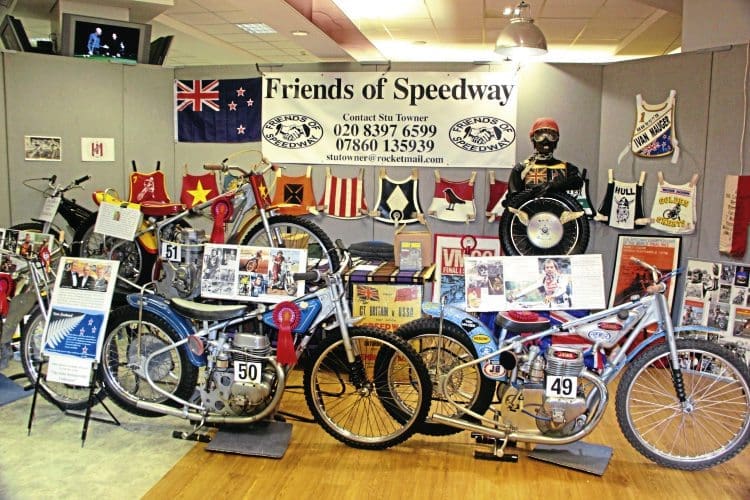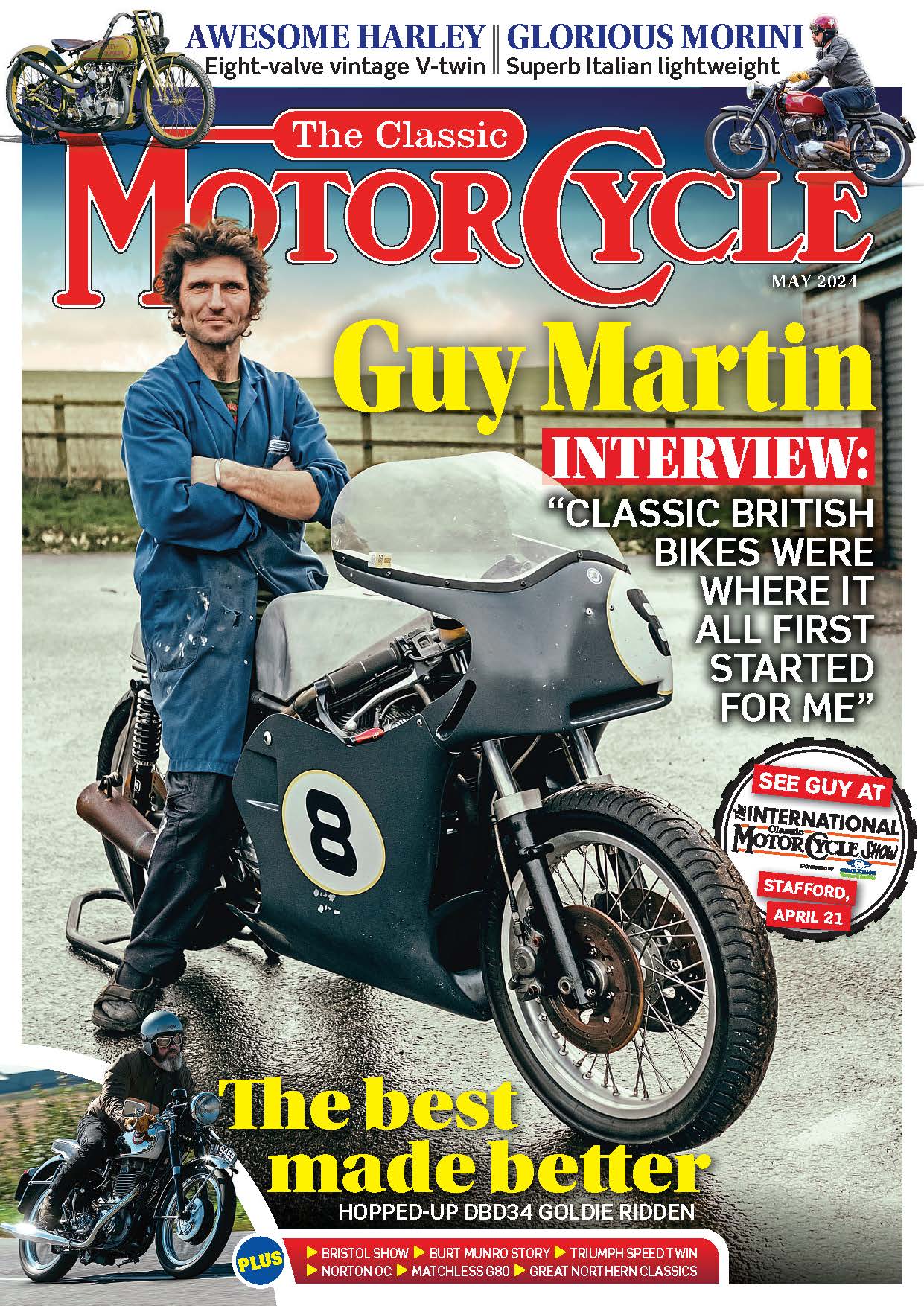The Southern Off-Road and Racing Show at Kempton Park was held on December 7, once more showing that classic sport is alive, well and thriving.
Words and photographs: ALAN TURNER
Kempton Park Race Course (horses, not bikes) was established more than 140 years ago, but for the last 30 of those, it has also been a venue for motorcycle jumbles.
Enjoy more Classic MotorCycle reading in the monthly magazine.
Click here to subscribe & save.
It quickly became a popular occasion, drawing traders and private sellers, and buyers, from many miles distant. The introduction of a show element, which took advantage of the space and facilities at Kempton, took things to another level.
For many years, Eric Patterson was the guiding light and he has now passed over the organisational reins, but he remains a regular Kempton presence.
His stand featured a newly published book that charts the history of the jumbles. While the laws of supply and demand dictate trading conditions, jumbles also mirror the changes in the classic motorcycle scene.
In recent years, an increasing number of bikes have been brought in from the continent. Obscure manufacturers and sometimes ‘barn-find’ conditions are obviously challenges that are not to be undertaken lightly.

There’s still plenty of potential British bikes for restoration, but the price tags on some indicate a level of optimism, contrasting with some Japanese offerings that could, at least, be secured with a reasonable outlay.
The off-road theme was notably prevalent at Kempton on this occasion, with enough trials bikes, or feasible projects, to equip possibly the entire entry for a centre-level mud plug.
Prices also seemed reasonable for usable off-roading entertainment, although the traditional big British singles needed far thicker wallets.
With possibly everything needed for bike, rider and workshop somewhere out in the jumble area, the show area in the basement of Kempton Park’s enormous grandstand was just as full. Within was a wonderfully diverse array of machinery covering the mainstream sporting disciplines, as well as the lesser-known ones, such as motoball.
With many club members on hand to talk about their choices, visitors would soon have their curiosity satisfied.
Competition for the best club stand was as keen as ever, with a great deal of effort put in to provide something different and eye-catching.
The Bultaco Club managed to feature a wide variety of the Spanish manufacturer’s output, the Normandy Club (a Surrey town, not France) also had variety, but ‘The Friends of Speedway’ were judged to have eclipsed everyone with speedway bikes and memorablilia, as well as special guest, four-times World Speedway champion Barry Briggs.
The uniquely US version of speedway, Flat Track, has gradually established itself in this country as a sporting discipline, as well as a fashion statement.
Offering encouragement, The Ace Café London has sponsored the Flat Track category at Kempton for several past shows.

The marriage of British machinery and functional US style offers a way of building something that is unusual but, with a few compromises, can also have the option of being ridden on the road.
The workmanship that had gone into Bob Frearson’s 1972 Triumph Trident-powered effort merited the top prize.
The broad church of Kempton is no better illustrated than in the ‘Highly Commended’ awards. From the prewar years, Peter Crummett’s superb Rudge and Max Groves’ Manx Norton were reminders of some of the more coveted machines of that era.
The Bantam Preservation Group managed well, as the club has only been in existence for three months, but is claiming 33 members so far.
One of the stand’s attractions was courtesy of member Steve Mitchell, who had rescued a genuine 1951 works BSA Competition Bantam.
The factory took this event seriously and the bike bristled with rider aids in its detail alterations. Successfully ridden by Fitzroy Allen to claim a gold medal in the ISDT of that year, it also took part in the 1952 and 1954 events.
After its last outing, and still retaining its official seals on many of the critical parts, the bike vanished into a shed for many years.
The engine was seized when Steve rescued it, so he took care to cause minimal disturbance to the provenance before he got the engine up and running once more.
John Seward’s Honda Elsinore recalled the time when the Japanese manufacturer was taking a serious interest in the burgeoning US off-road market.
Any one from the line of superbly prepared classic road-racers of the BRT stable could probably justify an award, but Neil Brailsford’s Tricati was the one that received the rosette. Dave Hutchens’ Daval König racer recalled an interesting period of road-racing in the Seventies.
When competitive 500cc race machinery for the privateer was no longer available, the light, powerful flat four German two-stroke engine seemed to be an answered prayer. The reality was not quite so straightforward.
The award-winning bike was the third of a trio, built in 1979 and the result of a six-year restoration.

The top three bikes at Kempton also reflected the show’s all-encompassing nature. Third was Dave Massam’s 125cc EMC-Puch, a rare survivor of when Dr Joe Ehrlich was pursuing theories on two-stroke design and came up with some successful road-racers.
In the ever-popular fire-up paddock the EMC was more than capable of holding its own in the onslaught on the ears! It provided an interesting contrast to the various four-strokes that were also demonstrated to the applause of an appreciative crowd.
Second place went to a 1963 Rickman Metisse belonging to Trevor Childs. The products of the Rickman brothers gave an economy in style to solid, functional engineering.
Still highly regarded in classic off-road events, the bikes are also in demand from collectors.
Best in Show was a fitting tribute to Robin Rhind-Tutt, who passed away recently. His Wasp engineering concern was also engaged in providing off-road machinery, but with the near-demise of the British bike industry, suitable power-trains had to come from elsewhere.

Mark Ramplee’s Wasp outfit had a Yamaha XS twin, enlarged to 840cc from its original 650cc. This considerable capacity hike still did not cause the engine undue stress.
The outfit was the dominant part of the Mortimer Classic Club’s display, an organisation that takes satisfaction in offering a busy programme of trials and motocross with a strong element of tradition.
With so much to see, Kempton is an intense experience, which is why the ‘Early Birds’ option of pre-opening admission is a popular one for the more determined buyers.
Recently, Kempton Park’s long-term future had been in doubt when the Jockey Club, its owners, had announced its intention to sell the land for housing development.
However, the local council has decided that Kempton should remain part of the green belt, so hopefully the jumbles and shows also have a bright future.
Read more News and Features in the March 2020 issue of The Classic Motorcycle – on sale now!
Advert
 Enjoy more The Classic MotorCycle reading in the monthly magazine. Click here to subscribe.
Enjoy more The Classic MotorCycle reading in the monthly magazine. Click here to subscribe.











